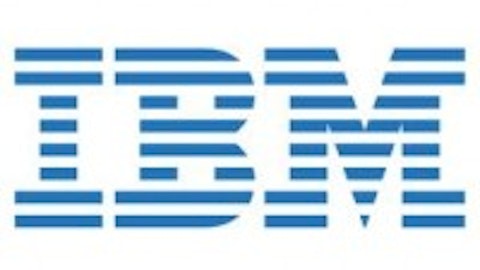When Microsoft Corporation (NASDAQ:MSFT) launched Windows 8 last year the operating system came in two “flavors”: Windows 8 and Windows RT. While Windows 8 is a full-featured operating system consisting of not only the new tile-based home screen and apps, but also the legacy desktop Windows RT features only the tile-based interface. Windows 8 runs on x86-based processors, the kind found in PCs and servers, while Windows RT runs on ARM-based processors, the kind found in most mobile devices.
There was a high level of confusion when Windows 8 launched. Both Windows 8 and Windows RT look the same, but only Windows 8 can run PC applications. Not only that, the name Windows RT does a terrible job of describing what that version of the OS does. Any other name, such as Windows lite or Windows ARM, would have made the situation far less confusing.
Sales of Windows RT tablets were poor to say the least, leaving many OEMs questioning whether or not the platform is viable. Tablets based on the full-featured Windows 8 performed much better in the market. Nokia Corporation (ADR) (NYSE:NOK), the phone maker responsible for the Lumia line of Windows Phones, was planning to design a Windows RT tablet but recently scrapped those plans in favor of a full-featured Windows 8 tablet instead. If there is any sign that Windows RT is dead, this is it.
What this means for Microsoft
Microsoft Corporation (NASDAQ:MSFT) made a mistake by creating Windows RT along with Windows 8. The rationale is understandable: since basically all tablets run on ARM-based processors it made sense to have a version of Windows that is compatible. But the problem is that any application designed for the Windows 8 desktop, and all legacy Windows applications, do not work on Windows RT. The real benefit of Windows 8 over Android and iOS is that it can run full-fledged legacy applications. Attach a keyboard and a Windows 8 tablet is a PC. Without this, Windows RT offers no benefit at all.
I suspect that Windows RT will be slowly phased out, as most Windows tablets going forward will likely feature Windows 8 instead. Microsoft Corporation (NASDAQ:MSFT) has a tendency to make a lot of mistakes which it later corrects, and Windows RT appears to be one of them. With the release of Windows 8.1 later this year, an update which fixes many criticisms about the OS, Microsoft Corporation (NASDAQ:MSFT) will be in a position to capture a significant part of the tablet market.
Earlier this year Samsung announced that it wouldn’t be making Windows RT tablets due to questionable demand. Nokia Corporation (ADR) (NYSE:NOK) joining that club likely spells the end of Windows RT. With Intel Corporation (NASDAQ:INTC) set to launch x86 processors which promise higher energy efficiency and lower cost, the purpose of Windows RT becomes clouded. If a consumer can buy a full-featured Windows 8 tablet for $300, what place does Windows RT have in the market?
What this means for Nokia
Nokia has seen success with its Lumia line of Windows Phones, and it’s only natural to expect a Windows tablet from the company sooner than later. If Nokia Corporation (ADR) (NYSE:NOK) had launched a Windows RT tablet it would have almost certainly done poorly.
Nokia may have an advantage being the dominant Windows Phone maker. In May Nokia Corporation (ADR) (NYSE:NOK) accounted for 80% of all Windows phone devices, and although the total market share of Windows Phone is small it is growing. This dominance could make Nokia tablets stand out from those of other manufacturers.
Nokia made the right call by dumping Windows RT, and given that Nokia is a Microsoft Corporation (NASDAQ:MSFT) partner I’d argue that this move is a death knell for Windows RT. If Nokia Corporation (ADR) (NYSE:NOK) won’t commit to the OS, then who will?
If Nokia can become the premier Windows tablet company much like it has become the premier Windows phone company than the company may return to profitability sooner rather than later.
What this means for Intel
ARM-based processors have typically been far more energy efficient than Intel Corporation (NASDAQ:INTC)’s offerings, but that is quickly changing. Intel Corporation (NASDAQ:INTC) recently launched the Haswell line of processors, mainly for PCs and high-end tablets, which offers greatly increased battery life for mobile devices. The company’s other line, Atom, is aimed at lower-end mobile devices and is being designed with low power applications in mind. The Nokia Corporation (ADR) (NYSE:NOK) Window tablets will likely run on an Atom chip.
For Intel Corporation (NASDAQ:INTC) the death of Windows RT is good news, since now all Windows tablets will likely run on Intel chips. Analysts have become concerned that Intel won’t be able to maintain its margins as it moves into the mobile space, but if Windows tablets become popular I think this concern is overblown. Intel Corporation (NASDAQ:INTC) was recently downgraded by analysts due to this issue.
The bottom line
Windows RT does nothing but muddle the Windows 8 picture. Microsoft Corporation (NASDAQ:MSFT) needs to drop it and focus solely on Windows 8. This would make its strategy much more coherent and be far less confusing for consumers. Nokia made the right call to drop Windows RT, and the company has a real shot at making a successful tablet with Windows 8 and Intel Corporation (NASDAQ:INTC) CPUs.
The article The Death of Windows RT? originally appeared on Fool.com and is written by Timothy Green.
Timothy Green owns shares of Microsoft. The Motley Fool recommends Intel. The Motley Fool owns shares of Intel and Microsoft. Timothy is a member of The Motley Fool Blog Network — entries represent the personal opinion of the blogger and are not formally edited.
Copyright © 1995 – 2013 The Motley Fool, LLC. All rights reserved. The Motley Fool has a disclosure policy.






